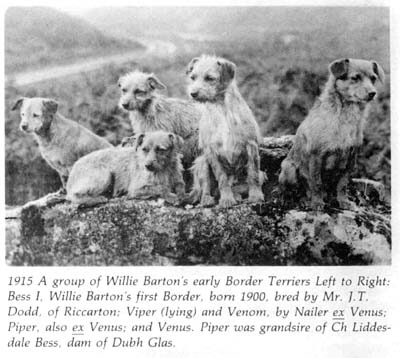 |
| Show dogs are about boxes and theories, not den holes and reality. |
On June 27th, 2012, the AKC added the "Russell Terrier" to their list of breeds fit for a rosette.
What's a Russell Terrier?
Like the "Parson Russell" Terrier invented before it, this dog is a show ring creation cocked up by fantasists who hope to sell puppies to romantics and those eager to get in on "the ground floor" of a "new breed that is actually very old."
Right. (cough :: cough )
The Wikipedia page on this breed tells you something else, of course. Here we find this bit of clap trap:
[The Russell Terrier] is a working breed not a companion breed. They are bred by dedicated Fanciers to preserve their working functional conformation and the instinct to employ their original purpose as earth terriers.
This is bunko advertising typed up by a dog dealer hoping to sell to a pretender, neither one of which will ever own a locator collar or dig a hole five feet to a dog facing formidable quarry underground.
Dedicated fanciers? What gibberish.
People who hunt their dogs are not "fanciers," they are hunters. They are killers. They are men and women who go into the field with worn boots, forged shovels, and steel digging bars, and who consider it a good day if their dog comes out alive and there are no vet bills to pay.
What does "working functional conformation" even mean? The only "conformation" requirement of a working terrier is that it have a chest small enough to get to ground, and on that score the only meaningful judge has four legs and teeth, not two legs and a Facebook account!
So what is a "Russell Terrier"?
Simply said, it's just another dog for the pet trade. It's one more tall tale from Kennel Club rosette chasers.
I have written the true history of the Jack Russell Terrier on numerous occasions in books, blogs, web pages, and magazine articles. A short version was told in Dogs Today last year.
The thumbnail version is that after the Kennel Club ruined the Fox Terrier by pulling it into the show ring and making it too big in the chest to actually fit down a hole, and with too soft a coat to actually thrive in winter, that dog fell out of favor in the field.
Kennel Club Fox Terriers as digging dogs? Mostly fantasy for more than 100 years.
Meanwhile, the popularity of the Jack Russell Terrier -- the non pedigree Fox Terrier -- soared.
In response, the Kennel Club decided to pull the working Fox Terrier, now called the Jack Russell Terrier, into the show ring for another try. There was only one small problem: the Jack Russell is a working dog and because the standard is the work, there's a huge variety in the size of the dog depending on what is being hunted and where. A working Jack Russell Terrier may stand anywhere from 10" to 15" tall.
What to do?
Kennel Club theorists have never let actual experience with working dogs get in the way of crafting "standards" or writing up just-invented histories. And why should they? After all, the folks in the Kennel Club are not actually interested in working dogs. Their interest is in ribbon-chasing and puppy peddling to people who want pets.
For these arm chair sages, the solution about what to do with an overly-broad working standard is as simple as a razor: cut the dog into two breeds and cut work and health out of the equation entirely.
A standard that required honest work below ground would make for too small a class at shows.
Simple tests to make sure the dog had a good nose and a solid voice would take too much time at ring side, and might reduce interest in the dog as well.
Remember, the Kennel Club sages tell each other, the goal here is to promote the breed and in order to do that we need to make it easy to participate.
Dog shows, after all, are a "sport" that caters to 60-year olds with bad knees and a little too much weight on the trunk. Asking these folks to dig three feet to a baying dog is a bit much, don't you think? Instead, how about if we simply judge the dog by walking it around the ring once on a string leash? And how about if we make allowances for the incompetent and infirm as well, and allow dog owners to pay someone else to walk their dog around the ring? I mean we do want to be inclusive, don't we? Not everyone has the time or the strength to attend a dog show and walk once or twice around a ring. Some people only have money, the poor things!
And thus was born the "Parson Russell" terrier, a dog created whole-cloth by the Kennel Club based on the putative "standard" of a man who hunted badger with his terriers -- a creature John Russell never hunted at all.
And the end result?
About what you would expect -- a dog sliding into the tar pits along the same route taken by the Fox Terrier 100 years earlier, with chests quickly becoming too big to work fox in natural earths, and with coats too soft to stand up in winter.
And what about the smaller dog?
This is the "Russell Terrier" -- the dog now on the cusp of making its formal debut on the Big Stage in the AKC.
The history here is a joke, of course. Believe it or not, the AKC ascribes the origin of this dog to Australia -- a country the Reverend Russell never so much as visited!
And are any of these "Russell Terrriers" actually worked to ground? Nope, not that I am aware of. And why would they be? You do not need Kennel Club registration to work a dog -- you need a locator collar and a shovel and a little knowledge about wildlife. Not much of that in the world of show dogs!
Now could a "Russell Terrier" work? Oh sure.
Provided a dog has a small enough chest and a little piss and vinegar coursing through its blood, any dog can probably be made to work underground if given experience and opportunity.
But working underground is not really the purpose of the "Russell Terrier," is it?
This is a dog designed for the pet trade and for show ring pretenders, not honest diggers.
Why not be honest about that and leave the Reverend John Russell out of the story, and the name of the breed too?
Oh right -- I forgot. Dog sales are all about story. You need romance. You need fantasy. You need nonsense and lies to drive sales.
Without those, pet buyers might as well be getting their dogs from the pound. Where's the cash in that?
.

























